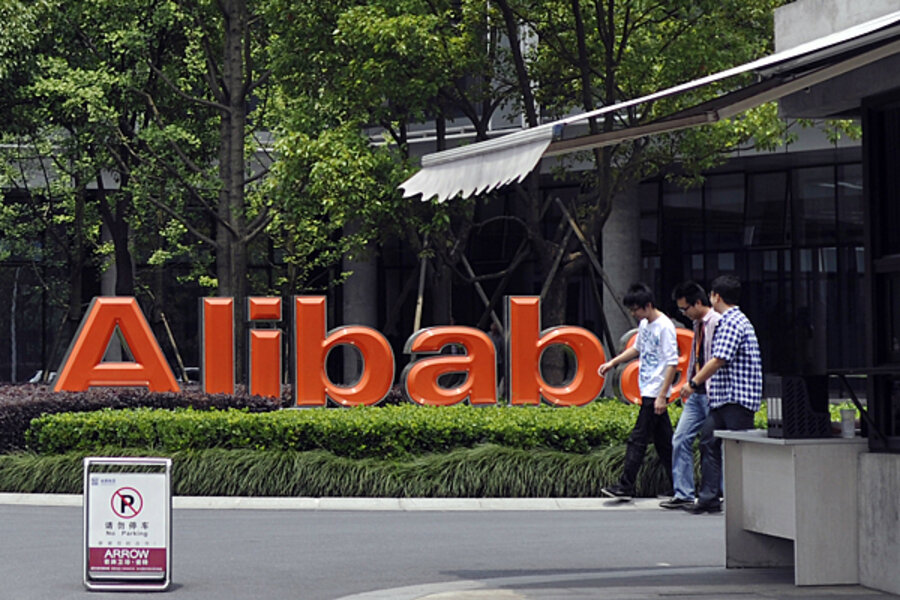Alibaba IPO could be bigger than Facebook, Twitter
Loading...
Tuesday, Chinese online retail giant Alibaba filed papers to go public on the New York Stock Exchange. The e-commerce company, bigger than Amazon and eBay combined but little known in the United States, was expected for months to launch its initial public offering in Hong Kong. But its intentions to file its IPO in the US became clear over the past several weeks.
Alibaba's debut is anticipated to be among the largest tech IPOs ever, creating a buzz in US investment circles not seen since Facebook's IPO announcement nearly two years ago. The company controls about 80 percent of the Chinese e-commerce market; it aimed to raise $1 billion in its IPO, but most expect it to raise much more. At CNBC, one analyst predicted the company's valuation could reach "over $200 billion," and the IPO could raise up to $15 billion. The valuation won't be locked down, however, until the company begins trading sometime later this summer.
Among the biggest early winners from the announcement were Yahoo! investors: The company has a 24 percent stake in Alibaba and is set to make billions by selling off even a small portion of its shares.
Many factors triggered Alibaba's decision – more and more Chinese companies are choosing to go public in the States, prompted by stricter regulations and disruptions of the IPO process in their home country. But the Alibaba IPO is part of a larger-than-usual swell of IPOs that hit US stock exchanges in 2013 and in the early part of 2014: A total of 222 companies went public in 2013, raising about $55 billion along the way – and 2014 brought more than 50 IPOs by the end of March, raising about $8.5 billion. Those IPOs are performing beyond expectations.
The average "first day pop" or price increase for an IPO in 2014 has been 22 percent, well above the typical 13 to 15 percent, according to Renaissance Capital, an IPO consulting firm based in Greenwich, Conn.
Recent IPO activity has been "the highest we had seen since the Internet bubble of 1999-2000," Kathleen Smith, an investment adviser with Renaissance Capital, writes via e-mail.
Why the surge?
"The market has become more receptive to IPOs at a younger age," says David Joy, a Boston-based market adviser for Ameriprise Financial, a national investment firm. "Years ago, you wanted to see several years of profitability before you were comfortable. That hurdle seems to [have been] lowered, and now investors are more willing to say 'you can price this off growth potential and revenue instead of actual earnings.' It's riskier, but for tech companies, the pace of innovation seems to be happening more quickly, and investing in the right ones can be far more rewarding."
Indeed, the flashiest names in the IPO wave have come from the consumer tech sector: Social networking site Twitter went public with a bang last fall, closing 73 percent above its opening stock price. Less successfully, King Digital, maker of the popular mobile game Candy Crush Saga, launched its IPO in late March, and GrubHub, a food-delivery website, launched in early April. But the surge in activity has come from a broad range of industries, including health care, biotech, energy, and the financial sector.
A few established, very well-known names are expected to launch IPOs in the remainder of 2014, including Chrysler (now owned by Italian automaker FIAT), air carrier Virgin America, and clothing retailer J.Crew.
Some of this is a symptom of the stock market itself, which went on a tear in 2013 and had its best year since 1997. As the market has begun to pull back a bit in recent weeks, the IPO calendar, too, has started to become less crowded, stoking fears of a 1990s-style tech-bubble bust.
Ms. Smith and Mr. Joy, however, aren't particularly worried about that. The current IPO surge, Smith notes, is "still half the levels of 1999-2000, which had 400 to 500 IPOs raising about $100 billion in each year." She calls the recent softening "a necessary correction that many had been looking for after such a strong sustained rally. "
A more sober analysis
"Back in the late '90s you just needed 'dot-com' in your name" to raise money to go public, Joy says. "[T]here was a belief that 'earnings don't matter, eyeballs do' – [that] all you had to do was visually attract traffic to your website. But you had to have a product that could be monetized, and people overlooked that. Now a much more sober analysis takes place."
So, should individual investors jump headfirst into the IPO market? Maybe not quite yet. Newly public companies are still the most volatile sector of the public-equity market, and huge hits are historically rarer than total busts. If you do decide to invest in IPOs, a portfolio approach combining safer bets like energy companies with higher-risk, but higher-reward sectors like biotech and consumer technology, is highly recommended. A diverse IPO portfolio can "help minimize volatility while capturing ownership of future market leaders," Smith says.
"Try and understand the space in which they're competing," Joy suggests. "Are they competitive? Is the valuation realistic long term? Can they generate enough earnings to justify pricing?"
"For an average investor, use only a small portion of your portfolio [on IPOs]," he says. "These are high-growth companies with high valuations. If it works out great, and if it isn't, you're not terribly harmed by it."






